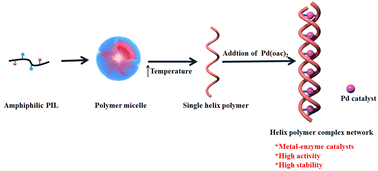From a single helix to a helical porous metalloenzyme catalyst based on temperature sensitive polyionic liquids†
Abstract
It is a challenging task to construct helical structures through the assembly of achiral polymers. Here, we synthesized a series of temperature sensitive polyionic liquids with different counterions. Polyionic liquids with an asymmetric structure assemble from micelles to a single helical structure with the increase of temperature. With the PIL as the soft template, Pd(oac)2 served as a crosslinking agent to further induce aggregation, and a helical porous polymer network was formed through multiple non-covalent bond forces. The resulting composite catalysts had high stability, a high specific surface area and amphiphilicity. The catalysts could catalyze Suzuki coupling and a one-pot Suzuki–Knoevenagel reaction in water with high efficiency, and the catalytic activity was not significantly reduced after it was recycled 10 times. PILs have multiple functions, including a micelle effect, solvent effect, activated catalyst, and self-catalysis. This study successfully provides a simple and green method for the design and synthesis of highly efficient and recyclable metal–enzyme catalysts and further promotes the development of multi-dimensional helical materials.



 Please wait while we load your content...
Please wait while we load your content...